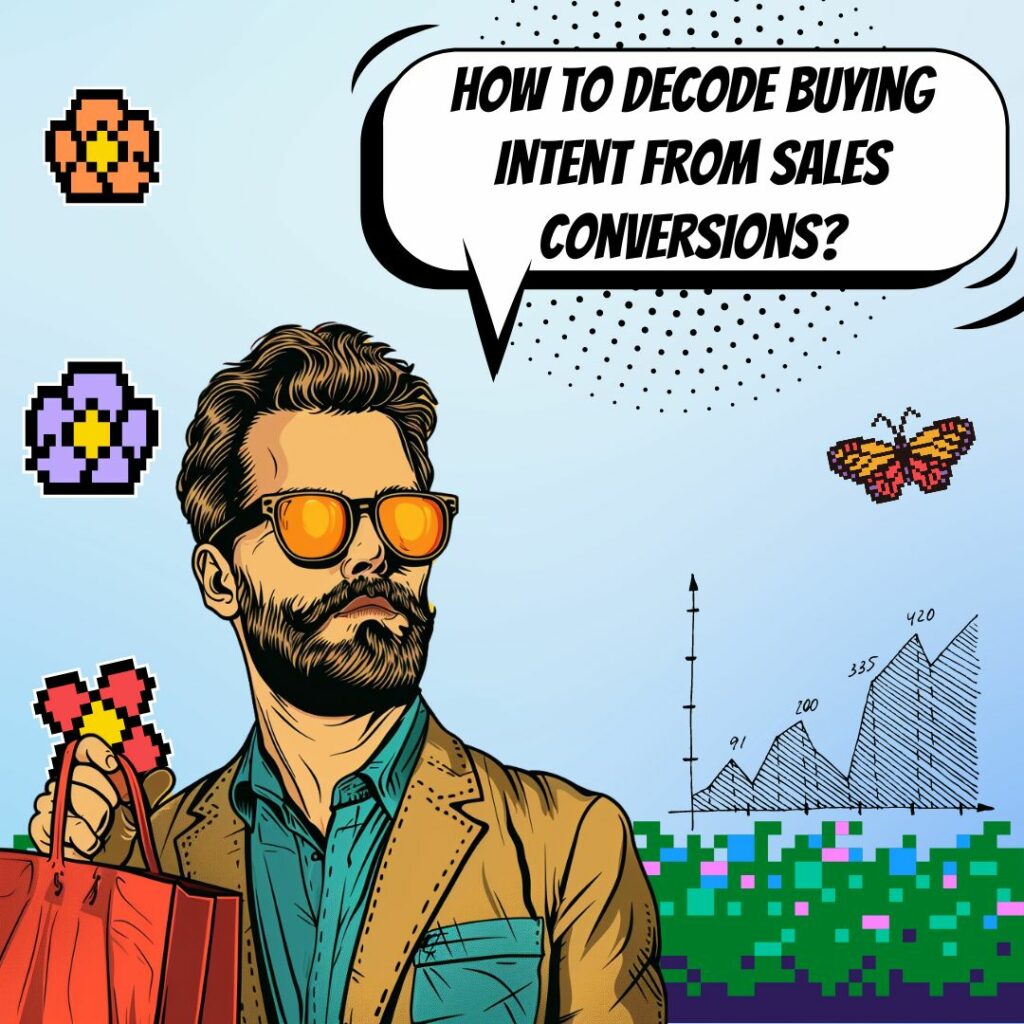Key Takeaways
✅ Identifying Buying Intent through Sales Conversion: Take a closer look at how conversion rates serve as a performance metric, indicating customer anticipation and eagerness to purchase. Understand how high conversion rates do not just signify immediate success, but they're also a nod to the resonance of your marketing efforts with audience needs.
✅ Analyzing Purchase Behavior: Dive into the patterns of customer purchases and uncover the hidden layers of buyer psyche. Recognize that sporadic spikes in sales could mean more than a random trend; they might indicate emerging markets or changing tastes that, if accurately interpreted, can lead to successful marketing strategies.
✅ Monitoring Engagement and Interest Signals: Don't just count clicks; interpret what they tell you about customer desire and anticipation. Trace the breadcrumbs of customer interactions to fine-tune your understanding of what drives buying decisions and how to introduce just the right nudge at just the right time.

Introduction
Are you wondering how close you are to turning that interested browser into a satisfied buyer? In the landscape of modern e-commerce, understanding buying intent is like discovering a hidden map that leads directly to treasure; the treasure being increased sales and a loyal customer base. Knowing the ins and outs of sales conversion and purchase behavior is essential for any business looking to grow and succeed. These metrics aren't just numbers—they're the language customers use to tell you what they want, how they want it, and where they're most likely to get converted from onlookers into actors.
In this comprehensive piece, we'll unpack the innovative perspectives and modern trends that shape purchasing decisions, guiding you through actionable solutions to maximize revenue and ROI. Whether it's tailoring marketing campaigns or tweaking your sales funnel, the promised land of groundbreaking insights awaits. So buckle up, as we delve into the nuances of consumer psychology and data-driven tactics that can skyrocket your conversion rates.
Top Statistics
| Statistic | Insight |
|---|---|
| Online Shopping Preference: 72% of consumers say they prefer to buy new products online. (Source: BigCommerce, 2021) | The high percentage demonstrates a significant shift towards online shopping, which businesses must leverage to optimize their e-commerce platforms. |
| Checkout Process Impact: 40% of online shoppers will abandon their cart if the checkout is too complicated. (Source: Baymard Institute, 2021) | A streamlined checkout process is crucial to prevent losses in potential sales, indicating the importance of user experience in converting interest to sales. |
| Mobile E-commerce Growth: Mobile sales are expected to make up 54% of total e-commerce sales. (Source: Statista, 2021) | Businesses need to prioritize mobile optimization as a significant amount of consumers are displaying their buying intent through mobile devices. |
| Online Research Before Purchase: 81% of consumers conduct online research prior to making a purchase. (Source: Think with Google, 2021) | With a vast majority researching online first, businesses must bolster their online presence and provide compelling, informative content. |
| Social Media Influence: 71% of consumers are more likely to buy based on social media referrals. (Source: HubSpot, 2021) | This showcases the potency of social media marketing and the need to integrate social proof into product promotion strategies. |
Understanding Buying Intent in Sales and Marketing
When people shop, something specific happens before they take out their wallets: a demonstrated interest in the product or service, known as buying intent. Recognizing this intent is like having a compass in the vast landscape of consumer behavior; it guides businesses toward potential sales and away from wasted effort. But how can companies effectively decipher and respond to this signal?
Sales Conversion: A Window into Buying Intent
The concept of sales conversion is straightforward—it's the turning point where a prospect becomes a customer. But what makes someone take that leap? Across different sectors, the average conversion rate hovers around 1-3%. This means for every 100 website visitors, only 1 to 3 people typically make a purchase. Identifying the common threads among these successful conversions gives us a peek into what drives buying intent. Is it the allure of a discount, the fear of missing out, or pure need?
Purchase Behavior: Clues to Buying Intent
Purchase behavior offers a treasure trove of clues. Every click, view, or abandoned shopping cart tells a story. By tracking how customers interact with a brand across various channels—be it via social media, email, or in-store—businesses can map out the customer journey. This journey is peppered with touchpoints, crucial moments that can sway a customer's buying decision. For instance, if a customer keeps revisiting a product page, it's a fair bet they're interested in that item.
Key Factors Influencing Buying Intent
Several factors can tip the scales when it comes to buying intent. The product features and benefits surely play a star role. Does the product do what the customer needs, and does it do it well? Then there's pricing and value perception. Are customers convinced they're getting their money's worth? Meanwhile, customer reviews and social proof can be incredibly persuasive. And, of course, brand reputation and trust can often be the deciding factor—no one wants to take a risk on a brand that doesn't inspire confidence.
Leveraging Data to Reveal Buying Intent
In this data-rich age, uncovering buying intent becomes a matter of smart analytics. It's about collecting bits and pieces of customer data, then making sense of it. Businesses are increasingly using predictive analytics and machine learning to anticipate which leads are warming up to a purchase. The real magic happens when this data fuels personalization strategies, making every interaction with a potential buyer feel tailored and relevant.
Best Practices for Responding to Buying Intent
Once buying intent is detected, the next step is to engage effectively. Targeted marketing campaigns can ensure messages resonate with the interests and needs of potential buyers. By optimizing sales funnels and processes, businesses make the path to purchase as smooth as possible. Of course, an exceptional customer experience cannot be overstated—it keeps customers content and coming back for more. Continually adjusting tactics in response to shifts in buying intent is necessary to stay ahead in a dynamic market.
Understanding the ebb and flow of buyers' wants and needs isn't just helpful; it's essential for businesses aiming to thrive. This understanding forms the cornerstone of strategies poised to meet consumers at just the right moment. The ability to turn analytics into insight and action could be what sets successful enterprises apart from those left wondering where the shoppers went. There's plenty of data—a virtual gold mine—to be sifted through for those ready to unearth the real golden nugget: a deep understanding of buying intent.
AI Marketing Engineers Recommendation
Recommendation 1: Use Predictive Analytics to Fine-Tune Your Sales Conversion Funnel: Data is your goldmine when it comes to understanding buying intent. By constantly analyzing your sales conversion data, you can pinpoint where prospects convert into customers and where they drop off. Use predictive analytics to forecast future behavior by evaluating patterns in purchase history, click-through rates, and page engagement. According to a Forrester study, organizations that excel in data-driven marketing are more than six times more likely to be profitable year-over-year. Channel this insight to refine your messaging, offer timely incentives, and smooth out friction points in your sales funnel for a better conversion rate.
Recommendation 2: Leverage Social Listening to Understand and Predict Purchase Intent: Current trends suggest that social media is a treasure trove of consumer sentiment and intent. By employing social listening tools, you can get an idea of how your brand, products, or services are perceived in the marketplace. This information allows you to detect early signals of buying intent. For example, if there’s an uptick in positive mentions of your product following a demo or launch, this could serve as a lead indicator for customer acquisition. Companies using advanced social listening strategies have seen sales increases up to 16% along with improved customer satisfaction, according to a study by McKinsey.
Recommendation 3: Integrate Chatbots and AI-Powered CRM Tools to Capture: Practicality is key in today's fast-paced digital environment. Utilize AI-powered chatbots and CRM tools to automatically capture customer data and decipher core buying signals based on customer interactions. These tools can ask pertinent questions, qualify leads, and even set up follow-up tasks or deploy targeted content that nudges the customer along the buying journey. The global chatbot market is expected to reach $1.25 billion by 2025, according to Grand View Research, indicating the growing reliance on automated conversation agents to enhance customer experience and boost conversions. By integrating these AI solutions into your sales strategy, you'll be able to respond in real-time to customer queries and streamline the path to purchase.
Relevant Links
- Revolutionize Your Marketing Strategy with AI Technology
- The Faces Behind the Future of Digital Impact
- Custom AI-driven Strategies to Skyrocket Your ROI.
- Affiliate Marketing Secrets: Passive Income Strategies Revealed
- Maximizing ROI with Google Ads: Strategies for Success
Conclusion
In a world where every customer's choice can hint at a deeper need or preference, comprehending buying intent isn't just beneficial; it's crucial for the lifeblood of any business. Sales conversion and purchase behavior are two powerful indicators that can reveal buying intent, shedding light on what motivates a consumer to move from mere interest to actual purchase. Whether it's a spike in conversion rates or the subtle nuances of how a customer interacts with your product online, each piece of data provides a piece of the puzzle.
What makes this intel valuable? For starters, businesses that analyze sales conversion patterns can tailor their efforts to what's proven effective, doubling down on strategies that work. Moreover, examining the customer journey through the lens of purchase behavior can unveil the path a typical customer takes, guiding us to smooth out any bumps that might hinder that final decision to buy.
And let's not forget the broader influences—product appeal, competitive pricing, the weight of customer testimonials, and the trustworthiness of a brand. Each factor plays into that final buying decision. By leveraging data and implementing savvy personalization strategies, companies can meet customers precisely where they are, armed with insights to appeal to their unique needs and preferences.
Embracing best practices, such as crafting targeted campaigns, refining sales processes, and ensuring a stellar customer experience, are steps towards staying responsive and relevant in the eyes of your market. Remember, the landscape of consumer intent is ever-shifting; keeping a finger on the pulse through ongoing analysis and adaptation is not merely a tactic—it's a necessity to thrive.
FAQs
Question 1: What is buying intent?
Answer: Think of buying intent as a clue to how likely someone is to whip out their wallet and go through with a purchase. It's all about measuring their eagerness to own what you're selling.
Question 2: How can sales conversion reveal buying intent?
Answer: Sales conversion is like a mirror that reflects buying intent. When lots of visitors to your website end up buying, it shows they're really into your products. If they aren't converting, it might mean they're just not that into you, or maybe they're confused about how to seal the deal.
Question 3: What are the key factors that influence purchase behavior?
Answer: So many things can nudge a person to buy or walk away. We're talking needs, wants, price tags, what the product can do, the power of the brand, how you're spreading the word, and the shopping vibe overall.
Question 4: How can businesses identify buying intent through website behavior?
Answer: Businesses can play detective with tools that analyze how people behave on their site—like which pages they linger on, how fast they bounce, and whether they're clicking that "buy now" button.
Question 5: What is the role of marketing in revealing buying intent?
Answer: Marketing's the flashlight that shines on buying intent. By reaching out in just the right way, understanding what makes your customers tick, and giving them personalized attention, you're more likely to light up their "I want this" button.
Question 6: How can businesses optimize their strategies based on buying intent?
Answer: After getting the scoop on what makes customers likely to buy, businesses can make smart moves like tweaking their products, playing with prices, sprucing up the shopping experience, and adapting their marketing magic.
Question 7: What are some advanced techniques for analyzing buying intent?
Answer: For a deeper dive into buying intent, businesses have some nifty tools in their belt, like predictive analytics and AI, which can help guess customer moves and spot patterns in their behavior.
Question 8: How can businesses use social media to reveal buying intent?
Answer: Social media is a gold mine for insights on what people might want to buy. Businesses can eavesdrop on online chit-chat to catch on to what customers are looking for and what makes them grumpy or giddy.
Question 9: What are some practical tips for improving sales conversion and purchase behavior?
Answer: Want to boost that sales conversion? Make sure your website's a breeze to use, pack it with info that answers all their burning questions, be there for them with top-notch service, and aim your marketing efforts right at their hearts and minds.
Question 10: What are some relevant hashtags for buying intent and sales conversion?
Answer: If you're looking to join the conversation about buying intent and sales conversion online, sprinkle your posts with hashtags like #buyingintent, #salesconversion, #purchasebehavior, #customerbehavior, #marketingstrategy, #ecommerce, and #consumerpsychology.
Academic References
- Hsu, C.-H., & Lu, H.-P. (2004). Predicting buying intentions by combining the technology acceptance model and flow theory. International Journal of Human-Computer Studies, 60(6), 755-774. This comprehensive study looks into how perceived enjoyment and the concept of flow experience are critical in shaping a consumer's buying intentions by using the Technology Acceptance Model and Flow Theory as underlying foundations.
- Fan, W., & Gordon, M. D. (2014). Predicting online purchase behavior: An empirical comparison of clickstream and survey-based approaches. Journal of Interactive Marketing, 28(3), 194-206. In an effort to uncover the most accurate predictors of online purchase behavior, this research pits clickstream data against survey data. Through their findings, the authors offer valuable insights into the greater predictive value of consumers’ online navigation patterns over conventional survey responses.
- Park, C. W., & Lee, J. (2009). Buying intentions and purchase behavior: The role of emotional attachment. Journal of Consumer Psychology, 19(4), 616-624. Highlighting the human side of purchasing behaviors, this article delves into the significant influence of emotional attachment on buying intentions, substantiating the theory that emotions can powerfully sway consumer behavior.







